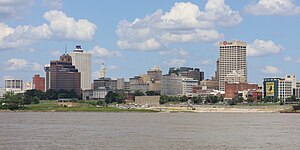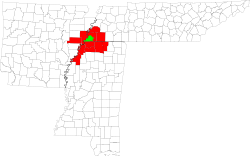The Memphis–Clarksdale-Forrest City Combined Statistical Area, TN–MS–AR (CSA) is the commercial and cultural hub of the Mid-South or Ark-Miss-Tenn. The census-defined combined statistical area covers eleven counties in three states, Tennessee, Mississippi, and Arkansas. As of 2020 census, the Memphis metropolitan area had a population of 1,389,905[1] The Forrest City, Arkansas Micropolitan area was added to the Memphis area in 2012 to form the Memphis–Forrest City Combined Statistical area. In 2023 the Clarksdale, Mississippi Micropolitan area was also added to form the new Memphis-Clarksdale-Forrest City Combined Statistical Area which as of 2023 had a population of roughly 1.4 million people according to census estimates.[3]
Memphis Metropolitan Area | |
|---|---|
| Memphis, TN–MS–AR Combined Statistical Area | |
 Downtown Memphis skyline | |
 | |
| Coordinates: 35°01′26″N 89°52′09″W / 35.0239°N 89.8692°W | |
| Country | United States |
| State(s) | Tennessee Arkansas Mississippi |
| Largest city | Memphis, Tennessee (656,861) |
| Other cities | Bartlett, Tennessee (58,264) Southaven, Mississippi (51,824) Collierville, Tennessee (48,655) |
| Area | |
| • Total | 4,599 sq mi (11,910 km2) |
| Population (2020) | |
| • Total | 1,389,905[1] |
| • Rank | 41st in the U.S. |
| • Density | 426.7/sq mi (164.8/km2) |
| GDP | |
| • MSA | $96.183 billion (2022) |
The greater Mid-South area has a population of 2.4 million, according to 2013 census estimates.[4] This area is covered by Memphis local news channels and includes the Missouri Bootheel, Northeast Arkansas, West Tennessee, and North Mississippi.[5]
Regional identity
editThe Memphis metropolitan area is part of the Mid-South of the United States. It is culturally more associated with the Deep South and the Mississippi Delta than it is the Upland South, which is the case with Tennessee's other large cities. Memphis, Tennessee, is the largest city in the Deep South, the third-largest in the Southeastern United States, and the eighth-largest in the Southern United States as a whole. African-Americans make up nearly half the population of the metro area. The Mid-South has the highest percentage of African Americans of all large metro areas with at least a million people. It is the second-largest when metropolitan areas under a million people are factored in after the Jackson-Vicksburg-Brookhaven, MS Combined Statistical Area.
The metro area is blue collar in nature and most of its growth can be attributed to its logistical infrastructure. Recently, however, more companies with technology backgrounds such as Electrolux and Mitsubishi have begun making inroads in the Memphis area.[6]
Economy
editThe Memphis area has a diverse and robust economy. Well positioned on America's largest river, the Mississippi, and located near the population center of the United States, Memphis is a distribution hub. FedEx maintains its global headquarters in Memphis and uses the Memphis International Airport as its global superhub facility making the airport the busiest cargo airport in the United States. UPS also uses Memphis as a hub. The area is also home to one of the United States largest intermodal logistics centers. This includes being the third-largest trucking corridor, fourth-largest inland port, and third-largest in class I railroad services. The Mid-South has the largest percentage of people employed in logistics in the U.S. The Mid-South is also home to several Fortune 500 and 1000 companies, including FedEx, AutoZone, Regions Bank, ServiceMaster, BUPERS, First Horizon Bank, International Paper, and others. Companies including Nike, Baskin Robbins, Sharp, and Hewlett Packard operate large distribution centers out of Memphis.[7]
Healthcare has begun to play a major role in the Mid-South's economy accounting for one in nine jobs. There are nineteen hospitals with over 4,100 beds in the Mid-South. The area is also home to St. Jude Children's Research Hospital, a Nobel Prize winning hospital with over 1,200 scientists working there and the University of Tennessee Health Science Center.[7]
Tourism
editTourism is also a major contributor to the Mid-South's economy with the region being known as the birthplace of Rock and Roll and Blues. Over eight million people visit the Memphis metropolitan area every year for tourist related activities. Over four million people visit Beale Street every year making it the most visited attraction in Tennessee. The Memphis Zoo is one of only four zoos in the U.S. to feature a giant panda and is routinely ranked as one of the best zoos in America. The Tunica casino resort area in Mississippi has over twelve million visitors annually and is the third largest gaming area in the U.S. after Las Vegas and Atlantic City.[7] It also contains a lake beach at Sardis Lake near Batesville, Mississippi.
Colleges and universities
editFour Year Colleges and Graduate Schools
- University of Memphis
- Rhodes College
- Christian Brothers University
- LeMoyne–Owen College
- Baptist College of Health Sciences
- University of Tennessee Health Science Center
- Southern College of Optometry
- Rust College
Two Year Colleges
Transportation
editThis article needs additional citations for verification. (April 2019) |
Airports:
- Memphis International Airport
- General DeWitt Spain Airport
- Olive Branch Airport
- Millington Municipal Airport
Freeways:
- Interstate 40
- Interstate 240 (Inner Beltway)
- Interstate 55
- Interstate 69
- Interstate 269 (Outer Beltway connecting Shelby County to Fayette and DeSoto Counties)
- Interstate 22 (Connects Hickory Hill and DeSoto County, Mississippi, to Birmingham, Alabama, and Atlanta, Georgia)
- Bill Morris Parkway (Connects Piperton, Collierville, Germantown, Southwind, and Hickory Hill to I-240)
- Sam Cooper Blvd (Connects East Memphis and Bartlett to Midtown)
- Tennessee State Route 300 (Located in the Frayser area, connects Watkins and the I-240 loop to U.S. Route 51)
- Interstate 555 (Connects Memphis to Jonesboro, Arkansas)
- Tennessee State Route 14 (Connects Raleigh to Memphis)
Composition
editThe area includes the following counties:
| County | Largest City | 2020 Census | 2010 Census | Change | Area | Density |
|---|---|---|---|---|---|---|
| Shelby County, Tennessee | Memphis | 929,744 | 927,644 | +0.23% | 785 sq mi (2,030 km2) | 1,184/sq mi (457/km2) |
| Desoto County, Mississippi | Southaven | 185,314 | 161,252 | +14.92% | 497 sq mi (1,290 km2) | 373/sq mi (144/km2) |
| Tipton County, Tennessee | Atoka | 60,970 | 61,081 | −0.18% | 473 sq mi (1,230 km2) | 129/sq mi (50/km2) |
| Crittenden County, Arkansas | West Memphis | 48,163 | 50,902 | −5.38% | 636 sq mi (1,650 km2) | 76/sq mi (29/km2) |
| Fayette County, Tennessee | Oakland | 41,990 | 38,413 | +9.31% | 706 sq mi (1,830 km2) | 59/sq mi (23/km2) |
| Marshall County, Mississippi | Holly Springs | 33,752 | 37,144 | −9.13% | 710 sq mi (1,800 km2) | 703/sq mi (271/km2) |
| Tate County, Mississippi | Senatobia | 28,064 | 28,886 | −2.85% | 411 sq mi (1,060 km2) | 68/sq mi (26/km2) |
| St. Francis County, Arkansas | Forrest City | 23,090 | 28,258 | −18.29% | 643 sq mi (1,670 km2) | 36/sq mi (14/km2) |
| Coahoma County, Mississippi | Clarksdale | 21,390 | 26,151 | −18.21% | 583 sq mi (1,510 km2) | 37/sq mi (14/km2) |
| Tunica County, Mississippi | Tunica | 9,782 | 10,778 | −9.24% | 481 sq mi (1,250 km2) | 20/sq mi (8/km2) |
| Benton County, Mississippi | Hickory Flat | 7,646 | 8,729 | −12.41% | 409 sq mi (1,060 km2) | 19/sq mi (7/km2) |
| Total | 1,389,905 | 1,379,238 | +0.77% | 3,989 sq mi (10,330 km2) | 335/sq mi (129/km2) |
Population history
edit| Census | Pop. | Note | %± |
|---|---|---|---|
| 1900 | 153,557 | — | |
| 1910 | 191,439 | 24.7% | |
| 1920 | 223,216 | 16.6% | |
| 1930 | 306,482 | 37.3% | |
| 1940 | 358,250 | 16.9% | |
| 1950 | 482,393 | 34.7% | |
| 1960 | 811,082 | 68.1% | |
| 1970 | 911,123 | 12.3% | |
| 1980 | 997,844 | 9.5% | |
| 1990 | 1,067,263 | 7.0% | |
| 2000 | 1,205,204 | 12.9% | |
| 2010 | 1,316,100 | 9.2% | |
| 2020 | 1,346,172 | 2.3% | |
| 2023 (est.) | 1,335,674 | −0.8% | |
| U.S. Decennial Census[8] | |||
Cities and towns
editPlaces with more than 500,000 inhabitants
edit- Memphis, Tennessee (Principal City)
Places with 50,000 to 100,000 inhabitants
editPlaces with 10,000 to 50,000 inhabitants
edit- Arlington, Tennessee
- Atoka, Tennessee
- Germantown, Tennessee
- Hernando, Mississippi
- Horn Lake, Mississippi
- Marion, Arkansas
- Lakeland, Tennessee
- Millington, Tennessee
- Olive Branch, Mississippi
- West Memphis, Arkansas
Places with 1,000 to 10,000 inhabitants
editPlaces with fewer than 1,000 inhabitants
editUnincorporated places
editDemographics
editAccording to U.S.census estimates for 2013,[11] there were 1,371,110 people residing within the CSA. The racial makeup of the CSA was 45.2% non-Hispanic White, 47.3% African American, 0.5% Native American, 2.2% Asian, <0.1% Pacific Islander, and Hispanic or Latino of any race were 5.1% of the population.[11] Memphis is the only metropolitan/combined statistical area in the United States with over a million people to have a plurality/majority African American population.[12] The Jackson, Mississippi metropolitan area also has this distinction but only has around half a million people.
The median income for a household in the MSA was $47,344 and the mean was $65,463. The median income for a family was $57,780 and the mean was $76,126. The per capita income for the MSA was $24,675.[13]
See also
editReferences
edit- ^ a b "2020 Population and Housing State Data". United States Census Bureau, Population Division. August 12, 2021. Retrieved August 14, 2021.
- ^ "Total Gross Domestic Product for Memphis, TN-MS-AR (MSA)". Federal Reserve Economic Data. Federal Reserve Bank of St. Louis.
- ^ "OMB Bulletin No. 23-01" (PDF). July 21, 2023. Retrieved August 3, 2023.
- ^ "State and County QuickFacts". Archived from the original on March 4, 2012.
- ^ "More than 90,000 Workers Commute from Other Counties to Selby, Census figures show (Commercial Appeal, Apr. 6, 2013)".
- ^ "New Study Forecasts 4,000 Local Manufacturing Jobs Through 2016". Memphis Daily News. Retrieved June 28, 2019.
- ^ a b c "The Memphis Market" (PDF). Archived from the original (PDF) on October 19, 2006. Retrieved June 16, 2013.
- ^ "U.S. Decennial Census". United States Census Bureau. Archived from the original on May 7, 2015. Retrieved May 28, 2013.
- ^ "Southaven population pushes above 50,000-mark (May 23, 2013)". Commercialappeal.com.
- ^ "U.S. Census website". Census.gov. Retrieved May 25, 2018.
- ^ a b Bureau, U. S. Census. "American FactFinder - Results". Factfinder.census.gov. Archived from the original on December 16, 2018. Retrieved June 28, 2019.
{{cite web}}:|last=has generic name (help) - ^ "Times Daily - Google News Archive Search". News.google.com. Retrieved June 28, 2019.
- ^ "Facts for Features: Labor Day 2012: Sept. 3 - Facts for Features & Special Editions - Newsroom - U.S. Census Bureau". Census.gov. Retrieved June 28, 2019.